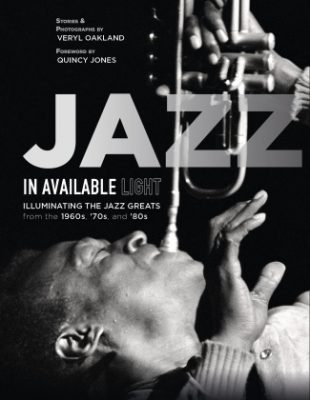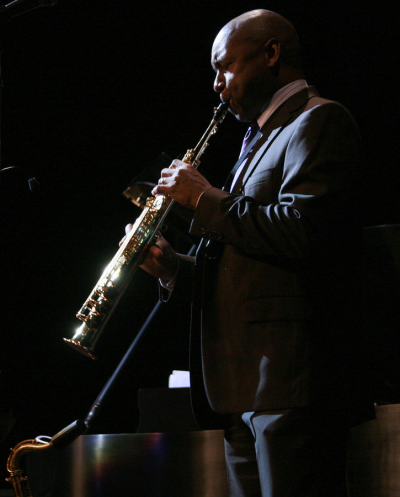.
.
.
…..Jazz in Available Light, Illuminating the Jazz Greats from the 1960s, ’70s, and ’80s is one of the most impressive jazz photo books to be published in a long time. Featuring the brilliant photography of Veryl Oakland — much of which has never been published — it is also loaded with his often remarkable and always entertaining stories of his experience with his subjects.
…..With the gracious consent of Mr. Oakland — an active photojournalist who devoted nearly thirty years in search of the great jazz musicians — Jerry Jazz Musician regularly publishes a series of posts featuring excerpts of the photography and stories/captions found in this important book.
In this edition, Mr. Oakland’s photographs and stories feature the great violinists Joe Venuti, Stephane Grappelli, Jean-Luc Ponty, Zbigniew Seifert, and Leroy Jenkins in a post titled “The Burgeoning Violin Wave”
.
.
All photographs copyright Veryl Oakland. All text excerpted from Jazz in Available Light, Illuminating the Jazz Greats from the 1960s, ’70s, and ’80s
.
You can read Mr. Oakland’s introduction to this series by clicking here
.
.
_____
.
.
© Veryl Oakland
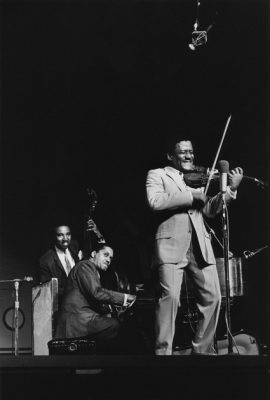
Violinist Ray Nance, with bassist Ray Brown and pianist John Lewis
.
The Burgeoning Violin Wave
Featuring: Joe Venuti, Stephane Grappelli, Jean-Luc Ponty, Zbigniew Seifert, Leroy Jenkins
.
…..From a historical standpoint, there was certainly nothing unusual instrumentally about linking violins and jazz music. Dating back to the early 1900s, popular ragtime and early New Orleans bands were just as likely to have included violinists as they did trumpeters and saxophonists.
…..But with some exceptions, notably: Stuff Smith, the heavy-vibrato, hard-swinging stylist who became the first to use an amplified violin; trumpeter-violinist Ray Nance, best known for his 20+years with Duke Ellington’s Orchestra; and the top strings player across Europe, Denmark’s Svend Asmussen, it was rare to see a jazz violinist make it to center stage on a regular basis in the decades to follow.
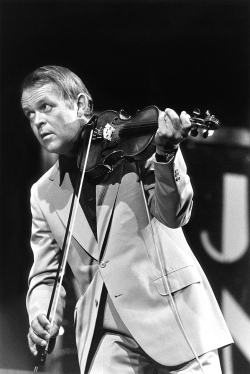 Svend Asmussen
Svend Asmussen
By the 1960s, the violin had become all but inconsequential as a jazz instrument. Yet by decade’s end, and from that point thereafter, everything changed.
Around the same time in the late ‘60s, two rejuvenated old-timers re-emerged on the scene, along with a youthful French trailblazer who soon electrified the violin. The listening public took notice of the refreshing sounds. Before long, the floodgates opened, bringing a virtual wave of new and extraordinary modern violinists. Nothing about jazz fiddlers would ever be quite the same again.
Because the “Violin Wave” has had such a sustaining effect – still progressing after more than half a century – it seems only appropriate to highlight just a few of the succeeding dominant violinists from the ‘70s and ‘80s whose jazz pedigree was without question, and whose legacies have ensured that this important movement continues.
.
.
___
.
.
© Veryl Oakland
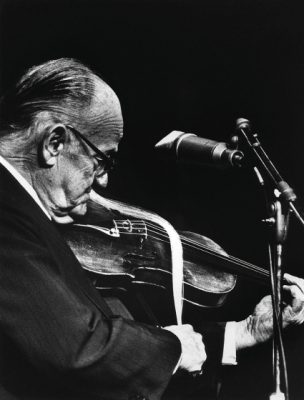
.
Joe Venuti
Concord, California
.
…..Acknowledged as the first artist to make the violin an accepted jazz instrument, Joe Venuti began winning over a whole new generation of followers just about the time he was ready to hang it all up.
…..Whenever I learned that Venuti would be appearing in my vicinity – even if it was hours away – I knew the trip would pay off. Whether watching him interact with fellow sidemen during rehearsals, or just catching him as he naturally lit up every crowd, he was always a kick.
…..The whimsical storyteller, who loved being the center of attention both on and offstage, took advantage of a couple of late career record dates and some favorable regional appearances – including serving as an occasional guest at Dick Gibson’s annual Colorado Jazz Parties – to exuberantly launch his way onto the international festival circuit. Somehow, he became an immediate and lasting hit. Venuti spent his remaining years in full discovery mode, wowing audiences and fellow musicians alike with his energizing, show-stopping presentations.
….Joe Venuti was one of the true musicians/entertainers who recognized the value of engaging his close friends and fans alike. When it came time for a Venuti solo, all anyone needed to see was the gaze of his fellow bandmates – almost on cue, trained on the portly performer. They knew the real excitement was about to begin.
.
© Veryl Oakland
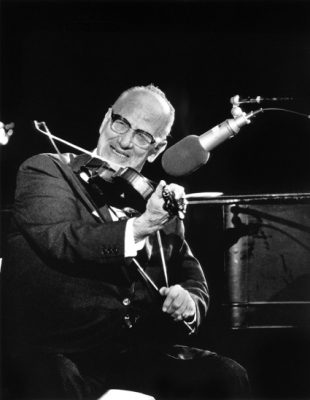
Giuseppe (Joe) Venuti – violin
Born: September 16, 1903
Died: August 14, 1978
.
.
___
.
.
© Veryl Oakland
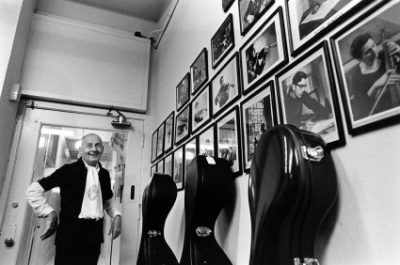
.
Stephane Grappelli
San Francisco, California
.
…..The striking senior best known from 1934 to 1939 as a key member of the famous Quintet du Hot Club de France with guitarist Django Reinhardt, Stephane Grappelli also took advantage of the resurgent interest in jazz violinists.
…..My opportunity to spend some time with the distinguished Frenchman materialized when I learned of his trip here in October of 1978. After tracking him down and suggesting we do a photo session together, he offered to meet while he was visiting at a violin-maker’s shop in the middle of Union Square.
…..For better than a decade, Grappelli had been reaping the benefits of all this renewed attention on jazz violinists. Now, at age 70, he was still a major player in the violin movement, having just completed his 11th recording in as many years – often with musicians half his age. On the big stage, he not only played the most elegant, lyrical lines on tender ballads, but could also swing like mad on uptempo standards.
…..Witty, charming, and always refined in appearance, Grappelli was the absolute jazz aristocrat who made anyone in his midst feel blessed by his presence. My day with Stephane, in this seemingly out-of-place – but most appropriate – establishment, was truly invigorating. For any and all who happened to drop by the shop that afternoon, their attention was centered not on the racks of rare violins, but on this most refined and rarefied visitor.
.
© Veryl Oakland
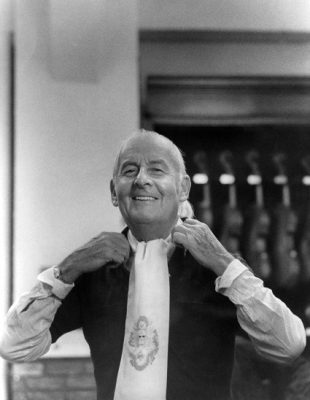
.
Stephane Grappelli (Grappelly) – violin, piano
Born: January 26, 1908
Died: December 1, 1997
.
.
___
.
.
© Veryl Oakland
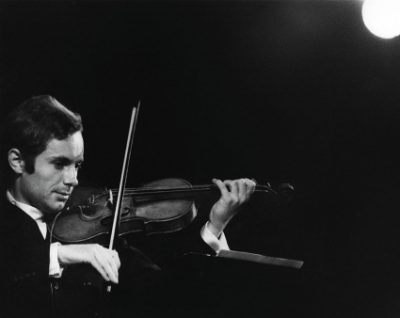
.
Jean-Luc Ponty
Monterey and Berkeley, California
.
…..While the two violin elders Venuti and Grappelli were once again reclaiming the spotlight, America got its first glimpse of the young man who would come to personify everything new and exciting about the jazz violin.
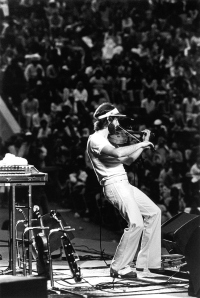
.
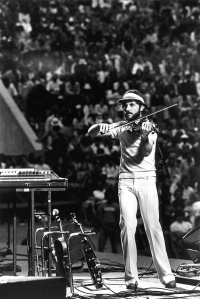
.
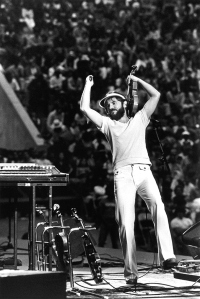
…..In his role as musical director for the Monterey Jazz Festival, pianist John Lewis of Modern Jazz Quartet fame, staged a “jazz violin conclave” for the 1967 edition, recognizing stalwarts Nance and Asmussen, but also introducing Jean-Luc Ponty as the lone representative of the new guard. The demure, almost shy 24-year-old’s first US performance drew a thunderous welcome and rave reviews, followed quickly by a recording contract.
…..Despite studying classical violin in his youth, Ponty initially distinguished himself by employing bebop phrasings that many critics branded just as exciting as those played by major horn soloists. From there, Jean-Luc completed a successful fusion crossover into the worlds of rock and electronic music, reaching vast, previously elusive audiences.
…..By the 1980s, Ponty’s transformation was well under way, both in his music and his appearance. Gone was the conservative, modest player with the boyish good looks content sharing the limelight with his fellow musicians. Now, sporting a full beard, the most fashionable attire, and an entourage befitting that of an international rock star, he was center stage wherever he went.
…..As I covered the violinist over a number of years, it was fun to watch how the performer, almost chameleon-like, changed both his image and style of playing, and with it the makeup of his passionate crowds. Everything about his presentations was now electric.
.
© Veryl Oakland
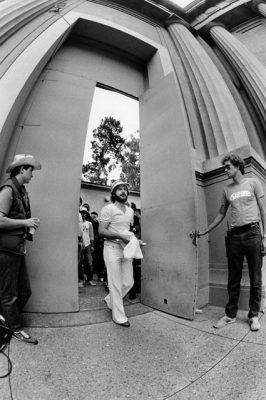
Jean-Luc Ponty – acoustic and electric violins, violectra, composer; also keyboards
Born: September 29, 1942
.
.
___
.
.
© Veryl Oakland
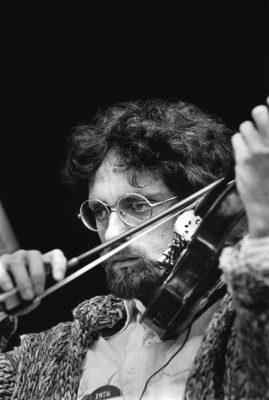
.
Zbigniew Seifert
Monterey, California
.
…..Among the many inspirational violinists who followed Ponty to critical acclaim was Zbigniew Seifert, formally trained at the Chopin School of Music in Krakow, Poland.
…..Like Ponty before him, Seifert’s classical aesthetics played a strong role in his early development. But he was also an accomplished saxophonist, and as a disciple of John Coltrane and his music, employed the tenor saxophonist’s phrasing and articulation throughout his many works. The response to his creations was quick and lasting, not only gaining him notoriety throughout the jazz world, but influencing a host of new violinists who would follow.
…..In Joachim Berendt’s The Jazz Book: From Ragtime to the 21st Century, Seifert described himself this way: “What I play on the violin, I imagine being produced by the saxophone. I…try to play as (Coltrane) would if his instrument were the violin.”
…..Although having tried that day, I never had the opportunity to meet the young Pole following his remarkable performance at the 1976 Monterey Jazz Festival, my only time witnessing him. My intent was to spend some time with this brilliant young innovator, certainly destined for greatness. And then he was gone.
.
Zbigniew Seifert (Zbiggy) – violin, composer; also alto saxophone
Born: June 6, 1946
Died: February 15, 1979
.
.
___
.
.
© Veryl Oakland
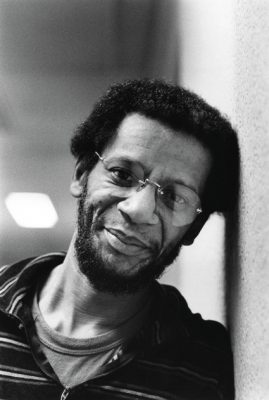
.
Leroy Jenkins
New York City, New York
…..Beginning in 1965, violinist Leroy Jenkins became one of the major players closely associated with Muhal Richard Abrams, the famed pianist-composer and founder of the Chicago-based Association for the Advancement of Creative Music (AACM) directly responsible for advancing jazz’s free movement.
…..From the beginning, the affinity that he – along with the dozens of others directly tied to the AACM – shared with Abrams would dramatically affect the progression of jazz music from that point forward.
…..By the 1970s, Jenkins epitomized the free-jazz period among violinists, often using percussive techniques with his instrument. His work with Abrams, along with other such avant-garde representatives as pianist Cecil Taylor and saxophonists Ornette Coleman, Anthony Braxton, Albert Ayler, and Archie Shepp, drew worldwide acclaim from enthusiasts hungering for change. As one of the boldest explorers of the instrument, Jenkins recognized that the absence of specific borders allowed him the freedom to maximize his creativity and expand the range of improvisatory violin.
…..On several occasions – and on both coasts – I met with Jenkins, a warm and inviting, self-assured artist who welcomed me into his inner circle, expressing – through both words and playing – his passion for life, his family, and his total commitment to the direction he was taking modern music. At one point, I remember him telling me something along the lines of the following: There’s no guarantee that what we create will be lasting, but if we believe strongly in what we’re doing, we’re obligated to get it out there.
.
© Veryl Oakland
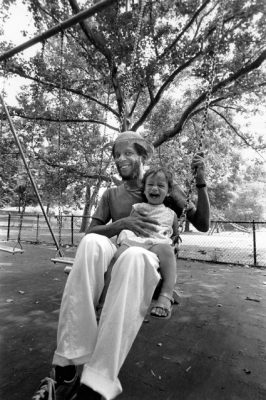
Leroy Jenkins – violin, viola, composer, educator
Born: March 11, 1932
Died: February 24, 2007
.
.
_____
.
.
.
Click here to read the edition featuring Stan Getz, Sun Ra and Carla Bley
Click here to read the edition featuring Art Pepper, Pat Martino and Joe Williams
Click here to read the edition featuring Yusef Lateef and Chet Baker
Click here to read the edition featuring Mal Waldron, Jackie McLean and Joe Henderson
Click here to read the edition featuring Dexter Gordon, Art Farmer and Johnny Griffin
Click here to read the edition featuring Thelonious Monk, Paul Bley and Cecil Taylor
.
Click here to read the edition featuring drummers Jo Jones, Art Blakey and Elvin Jones
Click here to read the edition featuring Monk Montgomery and the jazz musicians of Las Vegas
Click here to read the edition featuring Sarah Vaughan and Better Carter
.
.
.
All photographs copyright Veryl Oakland. All text and photographs excerpted with author’s permission from Jazz in Available Light, Illuminating the Jazz Greats from the 1960s, ’70s, and ’80s
.
You can read Mr. Oakland’s introduction to this series by clicking here
Visit his web page and Instagram
.
.




